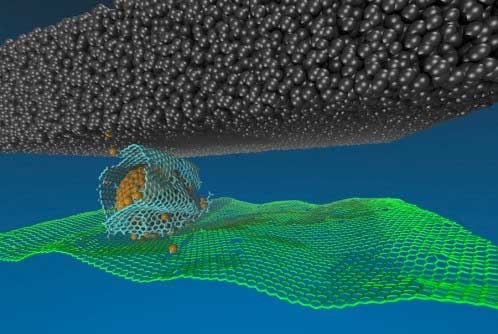| Jul 13, 2018 | |
Graphene - slippery when dry(Nanowerk News) Anyone who has ever taken their car in for an oil change recognizes the importance of reducing the friction that arises when steel touches steel. |
|
| Researchers at the U.S. Department of Energy’s (DOE) Argonne National Laboratory have been working for years to replace oil with solid lubricants such as graphene, which is a cheaper and more efficient substitute, one that lasts significantly longer. | |
| Argonne’s Laboratory Directed Research and Development (LDRD) Program, which gave them the seed money they needed to begin their experimentation, initially funded the work of Argonne researchers Anirudha Sumant and Ali Erdemir. | |
| Graphene can also be used to better protect ball bearings, which can corrode over time when exposed to water, the process commonly referred to as tribo-corrosion. The Argonne-developed process based on graphene has shown that a few layers of graphene not only reduces friction in steel rubbing against steel by seven times and the wear by 10,000 times but also significantly reduces the tribo-corrosion problem. | |
 |
|
| By creating the graphene-encapsulated diamond ball bearings, or “scrolls”, Sumant's team found a way to translate the nanoscale superlubricity into a macroscale phenomenon. (Image: Argonne National Laboratory) | |
| “That’s a significant improvement over any other existing solid lubricants coating available today,” Sumant said. “Also, the amount of graphene needed is very small and therefore cost is much lower and eliminating oil waste would be more environmental friendly, which is a great side benefit.” | |
| Sumant and his colleagues’ work has far reaching implications both inside and outside the automobile industry. It could help wind turbines move with greater ease, allowing them to produce more energy. It also can better seal off machinery as it pumps oil or gas from the ground or out at sea. | |
| The Argonne team, led by Sumant, who is a researcher at the Center for Nanoscale Materials, went on to win two additional grants totaling $1.4 million from the U.S. Department of Energy. | |
| It was through the initial LDRD funding that they recognized graphene as an emerging solid lubricant, one that works differently than existing oil-based and other solid lubricants, including graphite lube and even diamond-like carbon. | |
| Not only does graphene perform better, it’s more affordable. Even moderate quality graphene works great for tribological applications, which is not the case for various electronics and sensor applications. | |
| Most of the cost in conventional solid lubricant coatings relates to the infrastructure needed to apply it, including the electricity to run the related machinery and the machines’ maintenance. Not so with graphene, which can be applied by spraying a solution in the air and can coat any complicated shape or size — and over a large surface area. | |
| In an effort to bring their finding to the marketplace, Sumant and his team are currently working with two different companies in vastly different industries. | |
| The first is one of the world's leading providers of mechanical pump seals. It is working with the scientists to replace its silicon carbide seals with graphene, which would reduce wear and friction. | |
| The team also plans to work with another company from the automobile sector, which uses molds to create car parts, including door panels. Argonne researchers are seeking to develop a new lubricant that could reduce friction in metal forming applications and thereby bring down the cost of automobile manufacturing. | |
| Vivian Sullivan, LDRD program manager at Argonne, said the graphene experiment is an excellent example of how basic science can be used for practical means outside the laboratory. | |
| “Discoveries like this have real-world applications, which is exactly what the DOE is looking for,” she said. “It’s why the department threw its support behind this project after the initial round of LDRD funding.” | |
| LDRD supports high-risk, potentially high-value research and development. It encourages the creation of novel technical concepts and enhances the national laboratories’ ability to pursue their own strategic goals as well as those of federal funding agencies. | |
| “It’s one of the main ways the labs continually revitalize their research,” said Supratik Guha, Argonne’s Senior Science Advisor and director of the Nanoscience and Technology division and Center for Nanoscale Materials, a DOE Office of Science User Facility. | |
| LDRD monies also helped Sumant and his team acquire a high-temperature stage for their unique, multifunction tribometer, which helps study friction, wear and force between two surfaces at an almost immeasurable level. | |
| The equipment now has a permanent home in the Center for Nanoscale Materials and will soon be open for outside users. |
| Source: Argonne National Laboratory | |
|
Subscribe to a free copy of one of our daily Nanowerk Newsletter Email Digests with a compilation of all of the day's news. |
